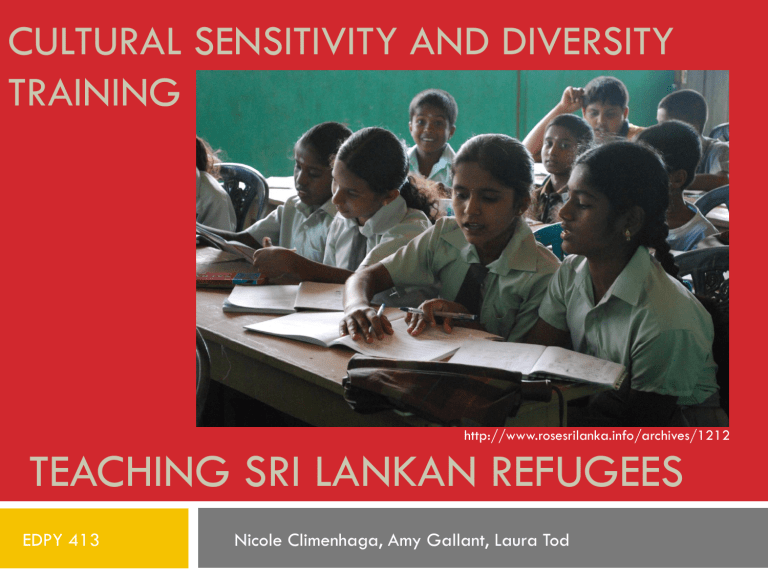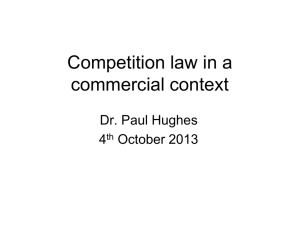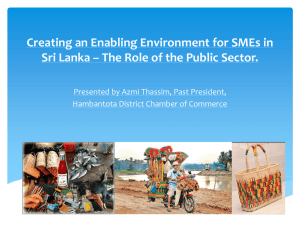Sri Lankan Refugees... - University of Alberta

CULTURAL SENSITIVITY AND DIVERSITY
TRAINING
http://www.rosesrilanka.info/archives/1212
TEACHING SRI LANKAN REFUGEES
EDPY 413 Nicole Climenhaga, Amy Gallant, Laura Tod
LANGUAGE DIFFERENCES
AND CHALLENGES
Sinhala vs English
Overview
Explore the similarities and differences that exist between the Sri Lankan language of Sinhala and
English
Talk briefly about the education system in Sri
Lanka and how that affects a refugee student coming to Canada
Look at some learning strategies that would help a
Sri Lankan a refugee student learn to speak, read, and write in English.
Sinhala -
National Language of Sri Lanka
The Sinhala language is spoken by the Sinhalese people, who constitute approximately 70% of the national population of Sri Lanka
The complete alphabet consist of 54 letters, 18 for vowels and 36 for consonants.
Means, R. (2011). Sri Lanka. Our World: Sri Lanka, 1.
The Sinhala language uses a type of alphabet called "abugida," meaning that consonants are written with letters, while vowels are indicated with diacritics on those consonants
Unlike in English, where both consonants and vowels are full letters
Translations from Sinhala to English are difficult as the letter sounds in the Sinhala language are far different from English and usually do not have an
English equivalent; or there are more than one
Sinhala sound for the English equivalent letter.
Which means:
Context is likely to get lost in translation
More confusing for refugee students to understand the
English language
Best to not attempt to compare the languages at all
Difficulties and Advantages
•
Difficulties
Completely different alphabet systems
The physical composition of the letters
The way in which both language use and write vowels
Pronunciation- Sinhala is a softer language than English, it has no hard consonant sounds and all of their words seem to flow one after another, where as in English, we have specific emphasis and breaks in our sentences for understanding.
•
Advantages:
Sri Lanka has a very formal education system similar to North America
The Sri Lanka's population has a literacy rate of 92%
98% youth literacy rate
Laws state all children must complete the first 9 years of their education in a formal education center
Choosing Strategies
Sinhala is so different from English that any strategies that one would choose would have to be able to be modified to the simplest stages in English learning.
The student will likely have no knowledge of the
English language and all strategies will have to be very rudimentary at the beginning, using visuals and actions as the primary method of communication
Language Acquisition and Development
Strategies
Strategies that are designed for language development aim to develop and support students vocabulary and basic comprehension skills .
(Herrel & Jordan,
2012, p. 83)
Interaction plays a big role in language acquisition strategies, these strategies are developed to meet the student at their level of development and guide them forward gradually.
Direct Method
The direct approach is ideal for a Sri Lankan student for a variety of reasons:
No translations from the L1 to English
Use of visual aids and pantomiming
Students are encouraged to speak in the target language and communicate as if in real life situations
However, This method is very teacher-centered and sometimes can be too time consuming if the teacher does not have any aids
Doggett, Gina. (2003). Eight Approaches to Language Teaching. CAL Digest. 165.
Example of Direct Method
1.
2.
3.
4.
5.
Sight Words:
–
Students are given cue cards with a vocab word on one side and a picture of the word on the other side, this strategy has
5 steps involved
Show- show student the picture side of the cue card
Say- Flip the card over and very clearly pronounce the word for the student
Try- Student make various attempts to pronounce new word
Mold- Teacher corrects student if necessary, pointing to mouth to show proper shaping of lips, tongue and relationship to teeth
Repeat- Student repeats each new word multiple times.
Total Physical Response Method
This method is based around research on first-language acquisition where children first listen and acquire receptive language before they speak
(Herrel & Jordan, 2012, chapter
12)
In this method the teacher would slowly introduce commands and act them out for the student as he/she verbalizes her actions
Students respond by copying the actions of the teacher as they say the vocabulary word
Total Physical Response Method
Key Points
Choose appropriate and applicable vocabulary
Introduce vocabulary gradually as to not overwhelm students
Stop the physical demonstration when the students seem to understand the command without your action.
Add additional responses, such as drawing pictures, to ensure the student fully understands the word
Assess progress and understanding, going back and repeating words previously learned
(Herrel & Jordan, 2012, chapter 12)
Collecting and Processing Words
Collecting words is a way for students to continually develop their vocabulary skills and word meanings
The children are encouraged to use the words they collect in their everyday writings
This method also teaches students inquiry and problem solving skills.
This method can be done as a class (writing a class word chart) or individually.
This is particularly helpful when teaching homonyms
Herrel & Jordan, 2012, chapter 17
Collecting and Processing Words
Key Points: :
(Herrel & Jordan, 2012, chapter 17)
Students identify words they are unfamiliar within a reading
Write the word in the word chart and ask students to explain the words or use them in a sentence.
Encourage many different sentences with many different uses of the word
Development of using in-text cues in older students
Example of Collecting and Processing Words:
Defining spelling words from a novel being studied by using context from the novel, and then using a dictionary to discover the correct definition.
Language Focus Lessons
Lessons which emphasize English vocabulary and usage, rather than the curricular content
(Herrel & Jordan, 2012, chapter 20)
Key Points:
Observe students common language errors
Introduce the vocab and model its use
Give students a hands on activity to use the vocab
Design an activity that allows you to observe students mastery of the focus language
This type of activity focuses on the problem areas that students are having in a way that applies the language issues to another subject
Literacy Development
Strategies for literacy development are developed to support English learners as they acquire reading skills and continue to develop their vocabulary and fluency.
(Herrel & Jordan, 2012, p. 141)
Research on developing literacy skills emphasizes the quality of instruction, the importance of interactions, and active participation.
(Herrel & Jordan, 2012, p. 141)
Literacy development includes: phonetic awareness, phonics, oral reading, comprehension, and writing skills.
Shared Reading
Students (whole class or small groups) read a text out loud with the teacher.
If a student cannot read the words, they are still hearing the words read aloud and discovering how they should sound
Teacher can use illustrations to go along with the text, use think-aloud strategies to teach problem solving
Using shared reading with a refugee student is beneficial because they are not put on the spot and singled out if they cannot read a word. They can read with more confidence.
Herrel & Jordan, 2012, chapter 24
Modeled Writing
Acquiring English writing skills is going to be the hardest aspect of
English for a Sri Lankan refugee student
It is important to have a good understanding of what the students already understand about writing in English
For our refugee student, they would be in the earliest beginning stages for writing English, and even the simplest tasks will have to first be modeled by the teacher
Modeled writing provides the student with a demonstration of how English sounds are represented by symbols
(Herrel & Jordan, 2012, chapter 28).
Modeled Writing
Key Points:
Choose a simple sentence and write the words slowly, sounding out each work as you write it.
Read and point to the words slowly but fluently
Reread the sentence with the student, pointing to each word as you read
(Herrel & Jordan, 2012, chapter 28)
Bringing it all together
The one aspect all of the strategies stress the most is ensuring that you know the amount of English that your students know prior to starting an activity.
If you give a student an activity that is beyond their understanding, it will only frustrate them.
The most successful strategies meet the students need and slowly guide them to the next stage in development
For a Sri Lankan Refugee
It is important to remember students are learning a completely new alphabet and way of speaking as well as the new words in English
Modeling is the best way to demonstrate new words and sounds to a refugee student
Incorporating visuals into your lessons are a great way to link prior knowledge that the student cannot yet verbalize
CULTURAL DIFFERENCES
AND PAST EXPERIENCES
http://www.ft.lk/2011/04/09/sri-lanka-tourism-celebrates-‘people-and-culture’-in-april/
Overview
Sri Lankan Culture
Sri Lankan Religion
North American Differences
Similarities
Sensitive Topics
Support http://anfrel.org/category/country-profiles/sri-lanka/
Sri Lanka
The two largest ethnic groups:
Sinhalese (Majority)
Caste system
Arranged Marriages and Family connected
Tamil (Largest Minority)
Additional Minority Groups
Moors
Berghers
Types of Religions
Majority : Buddhist
Other: Hindu, Muslim, and Christian
Cultural Values
Cricket-could be incorporated in physical education
Holidays to Acknowledge
Buddhist Holidays :Perahera, and Poya.
Hindus Holidays :Thai Pongal and Deepavali
Muslim Holidays: Milad-un-Nabi
Christian Holidays: Most celebrated in Canada
Consider Family Dynamics
Arranged Marriages
Caste system (Means, 2011)
Cultural Differences and Challenges
Holidays acknowledged and celebrated in Canada
(primarily Christian or western holidays)
Family dynamics- Arranged marriages are not common and support for them may be challenging
Cultural Similarities
Value Education
Multiple Cultures
Canadian Identity vs. Sri Lankan
Identity
Media
Consumer based
Biased news reported (Hodkinson, 2011)
Refugees from Sri Lanka
Financial limitations
Isolation by media forms
Sensitive Topics
History of Events in Sri Lanka
Civil War- dating back to 1949 (Anonymous,
2012)
Conflict between Sinhalese and Tamil (Means, 2011)
Refugees form both sides (Means, 2011)
Violent images may trigger painful memories
Tsunami – 2004 More than 30,000 died
(Anonymous, 2012)
Stages of Cultural Acceptance
Stage One – Excitement and interest
Stage Two- (Culture Shock)
Stage Three- (Culture Stress)
Stage Four- Recovery Stage
(Dissanayake & McConatha, 2011).
Brown, H. D, (2000). Principles of language learning and teaching, Fourth Edition, Prentice Hall
Regents pp. 184-185.
Community Support
Community activities http://www.slcfa.org/site.html
Cultural Events
Atmosphere Changes
Climate
Sri Lanka: Humid and Warm
(Means,
2011).
Alberta: Cold and
Dry
Educating students and families about warm clothing http://anfrel.org/category/country-profiles/sri-lanka/
Conclusion of Culture
Not one single culture
Consider the individual over the entire culture
CLASSROOM IMPLICATIONS
http://www.myseveralworlds.com/2011/03/18/the-esl-educators-guideclassroom-management-techniques/
Community Support
Sri Lanka Canada Friendship Association of
Edmonton
Advice on cultural differences and customs – first hand information added to your own research
A place to suggest to family of student http://www.slcfa.org/site.html
Teaching Strategies
Work in small groups or pairs – socializing and using language – good way for students to compare and contrast cultural norms
(Herrell A., Jordan. M. 63.)
Use a variety of texts and visual images
Want to create the conditions necessary to enable students to participate in creating and changing meaning and values
(Thinking about Teaching. Custom Edition for the University of Alberta. (2010). Boston: Pearson Learning Solutions.
77.)
Including Parents and Families
Invite parents to be a part of the classroom when they arrive, do not wait until Parent Teacher
Interviews to get to know them
Make sure there is strong communication between home and school
Invite them to be a part of the school community – be their tour guide at a school BBQ or Open
House
Classroom Community that Embraces
Diversity
As a class, research where our new student is coming from
Where is Sri Lanka? What sports do they play? What language do they speak? What foods do they eat? What’s the weather like?
When the new Sri Lankan student arrives, have your whole class research and present their own cultural backgrounds.
Illustrate cultural differences as a good addition to the classroom how Canadians have different backgrounds
Classroom Set-Up and Management
Establish routines to help elevate anxiety – modeled by teacher
Example) List of days activities in order and at times they will occur – same place everyday
(Herrell A., Jordan. M., pp. 18-19.)
Use signals and hand gestures for your students who have little English Language Proficiency
(Herrell A., Jordan. M., pp. 18-19.)
Try not to place ELL students at the back or front of classroom
Place images throughout your classroom that are not all
English texts or images from Canada
The Hidden Curriculum
Refers to the tacit teaching of norms, values, and dispositions that occur through students’ participation in social experiences in routine school activities
Students need the skills and knowledge to uncover the hidden rules and expectations that affect their dispositions, identities, and personalities.
May not be part of the curriculum but attribute to students progress of identity and personality.
(Thinking about Teaching. 76.)
The Hidden Curriculum
Schools act as agents of Moral Socialization – school instill an idealized version of society’s values
Political Socialization – the role schools plays in introducing the values and norms that support the structure of society, including the dominant political ideals
(Thinking about Teaching. 75.)
Plan for the Unexpected
Find aspects of school life that we take for granted and would never see as an issue or possible cause of stress or trauma.
These students are refugees, will they respond to a lock down or fire drill the same way our Canadian students will?
Be sensitive to the difference in the school environment which may seem familiar for North
American students
Create a Welcoming and Supporting
Environment
Remember these students are coming into a new school culture and we need to be flexible with our expectations
Create a positive student-teacher relationship and try to learn from your Sri Lankan students just as they learn from you
Create a classroom that emphasizes diversity not difference
References
Anonymous. (2012). Sri lanka profile. BBC News, Retrieved from http://www.bbc.co.uk/news/world-south-asia-12004081
Beiser, M., Simich, L., Pandalangat, N., Nowakowski, M., & Fu, T. (2011). Stresses of
Passage, Balms of Resettlement, and Posttraumatic Stress Disorder Among Sri Lankan
Tamils in Canada. Canadian Journal Of Psychiatry, 56(6), 333-340.
Brown, H.D, (2000) Principles of language learning and teaching, Fourth Edition, Prentice
Hall Regents p 184-5
Dissanayake, M. P., & McConatha, J. (2011). A Comparative Investigation of the Self
Image and Identity of Sri Lankans. World Cultures, 18(2), 1-19. Retrieved from http://ehis.ebscohost.com.login.ezproxy.library.ualberta.ca/eds/detail?vid=2
&hid=6&sid=820dda4a-fc55-4117-a90ef7ebbb5cf95c%40sessionmgr11&bdata=JnNpdGU9ZWRzLWxpdmUmc2NvcGU9c2l0Z
Q%3d%3d#db=sih&AN=67270548
Doggett, Gina. (2003). Eight Approaches to Language Teaching. CAL Digest. 165.
References
Herrell A., Jordan. M. 50 Strategies for Teaching English Language Learners.
(2012). Boston: Pearson.
Thinking about Teaching. Custom Edition for the University of Alberta. (2010).
Boston: Pearson Learning Solutions
Sri Lanka Canada Friendship Association of Edmonton http://www.slcfa.org/site.html
Means, R. (2011). Sri Lanka. Our World: Sri Lanka, 1.
Wikipedia. (2012). Education in Sri Lanka. Retrieved from http://en.wikipedia.org/wiki/Sinhala_language (Alphabet Image)






